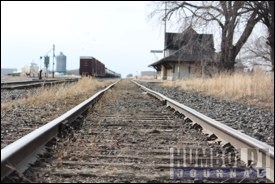The railway line is an essential part of Humboldt's past, present and future. Without it, the city might not have evolved beyond a few ramshackle homes in the middle of an empty plain. Like almost any technology, though, railways can also be dangerous, as evidenced by the July 2013 disaster in Lac Megantic that left 47 people dead. It is that factor that is at the heart of Rail Safety Week, set to run from April 28 to May 4.
Supported by Operation Lifesaver, a rail safety advocacy organization, the week is designed to raise awareness about preventable rail accidents, which Operation Lifesaver says result in the death or serious injury of 130 people every year.
Of course, the vast majority of train accidents aren't as publicized or devastating as what happened in Lac Megantic. The past year has seen several train incidents in Saskatchewan: In May an 85-car CP train went off the rails near Jansen, leaking crude oil; in November a CN employee was killed near Crooked River after being struck by a freight train; and in January a truck driver died in Raymore after his semi-trailer collided with a train.
"It is very important that people are aware of the dangers of railways and trains," said Tracey Shewciw, the executive director of Safe Communities Humboldt & Area, an organization dedicated to preventing injuries and raising awareness. "We believe we're making a difference. There aren't a lot of injuries in our area due to trains."
Organizations like Safe Communities Humboldt focus their efforts on education and awareness campaigns in the hope that people will take the danger of railway crossings seriously.
"A lot of people have the attitude of, 'It's not going to happen to me'", Shewciw said. "The idea that it always happens to someone else in some other community. People need to be aware that it can happen here and it does happen to us. That's how I'd like everybody to approach the issue."
While the city will not be formally involved in Railway Safety Week beyond a proclamation from the mayor, Coun. Roger Nordick, who has a long history in emergency services and preparedness, wants to make sure everyone in the city is aware of how important rail safety is.
"Anyone who lives in Humboldt can see that risks are a common occurrence," Nordick said. "We have numerous crossings and people are always trying to beat the train. To my knowledge there hasn't been a collision, but the risk is always present."
With the time it takes for a train to come to a complete stop, a fatal accident is only a stall or trip on the tracks away from happening. Nordick said CN has been helpful in reducing train speeds as they pass through towns and cities, but there's little doubt that people are constantly taking risks to avoid having to wait 10 or 15 minutes for the train to pass. Those kinds of risks take on an even more dangerous character when the train is shipping potentially dangerous goods like oil or chemicals.
Nordick, who was the city's fire chief in the 1980s, said he used to get printouts from the rail companies that would indicate when dangerous goods were being shipped through town. It was useful information, though those dangerous goods were going to be coming through no matter what.
"All you can do is prepare for things that are common to this area," Nordick said.
Shewciw added that the city's emergency measures officer has plans created in case of a train derailment or other type of disaster. It is one of the major concerns in the area, but like any sort of disaster preparedness, the likelihood that any of those plans will be deployed is very slim. The more mundane crossing accidents don't get the same sort of headlines, but are much more likely to happen and so are the focus of any kind of rail safety awareness campaign.
"Trains are getting longer, getting faster, and communities are growing," Shewciw said. "A lot of farmers have to cross rail lines every day, and our job is making them aware every time they cross that they need to be vigilant."
Nordick grew up in the Humboldt area and has spent decades living alongside railways, where he still sees many of the same risks being taken that were common 20 or 30 years ago.
"Rail safety has always been a major concern," he said. "People are still taking the same risks. The only difference is that there's a lot more traffic now."
With more traffic comes more risk for an accident. The hope for those behind Rail Safety Week is that it helps bring that risk down by changing the way people behave around railway crossings. If that happens, it will have been a success.




